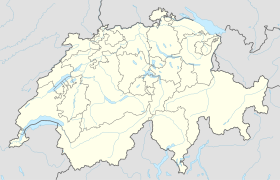Bollodingen
| Bollodingen | ||
|---|---|---|
| State : |
|
|
| Canton : |
|
|
| Administrative district : | Oberaargau | |
| Residential municipality : | Bettenhausen | |
| Postal code : | 3366 | |
| former BFS no. : | 0974 | |
| Coordinates : | 620 576 / 224 127 | |
| Height : | 475 m above sea level M. | |
| Area : | 2.0 km² | |
| Residents: | 205 (December 31, 2010) | |
| Population density : | 103 inhabitants per km² | |
| map | ||
|
|
||
Until December 31, 2010, Bollodingen was a political municipality in the Oberaargau administrative district in the canton of Bern in Switzerland .
On January 1, 2011, Bollodingen merged with the community of Bettenhausen .
geography
Bollodingen lies at 476 m above sea level. M. , two kilometers south of Herzogenbuchsee and eight kilometers southwest of the city of Langenthal (as the crow flies). The street line village extends in the plain of the Önztal , on the Önz near the confluence of the Altachen , on the northern edge of the Molasse hill country of the higher Mittelland (Buchsiberge), in the Oberaargau .
The area of the 2.0 km² municipality covers a section of the northern Bernese Mittelland . The central part of the area is taken up by the approximately 1 km wide plain of the Önztal. The central section of the Önz flows in a valley that for a long time lay on the edge of the Ice Age Rhone Glacier and served as a meltwater channel. The valley level is flanked in the west by the height of Steinhof, of which the Oberholz (up to 535 m above sea level ) still belongs to Bollodingen. To the southeast, the municipality extends to the Molasse height of the Humberg , on which 597 m above sea level. M. the highest point of Bollodingen is reached. In 1997, 7% of the municipal area was settled, 30% forest and woodland, 62% agriculture and a little less than 1% was unproductive land.
The outlying settlement of Hege ( 473 m above sea level ) north of the village and some individual farms belong to Bollodingen .
population
With 205 inhabitants (as of December 31, 2010), Bollodingen was one of the small communities in the canton of Bern. 98.6% of the residents are German-speaking, 0.9% French-speaking and 0.5% speak English (as of 2000). The population of Bollodingen was 274 in 1850 and 239 in 1900. In the course of the 20th century, the population decreased slightly to 201 by 1980. Since then, a slight increase in population has been recorded.
Water supply
The water supply is the responsibility of the municipal association of water supply on the lower Oenz (WVOe). Like many other water suppliers, the WVOe has to contend with chlorothalonil metabolites . Water samples from 2019 showed that the applicable maximum values were exceeded in four of the WVOe's drinking water catchments. As a result of the heat and drought in 2019 , customers were asked in July of the same year to reduce their water consumption .
economy
Until the second half of the 20th century, Bollodingen was predominantly an agricultural village. Even today, arable farming , fruit growing (near the village) and cattle breeding have an important place in the income structure of the population. A few more jobs are available in local small businesses and in the service sector, including in mechanical engineering and window manufacturing companies. In the last few decades the village has also developed into a residential community. Many workers are therefore commuters who mainly work in the Langenthal - Herzogenbuchsee region.
traffic
The community is located off the major thoroughfares, but is easily accessible from the Herzogenbuchsee regional center and from the main road Burgdorf - Langenthal . Bollodingen is connected to the public transport network by a bus line that runs from Herzogenbuchsee to Langenthal.
history
The place was first mentioned in a document in 1262 under the name Polatingen . The names Bolathingen (1266), Bollendingen (1533), Bollondingen (1554) and Bollodingen (1850) appeared later . The etymology of the place name is not clear. Bollodingen probably goes back to the Old High German personal name Bollhard and therefore means for the people of Bollhard .
In the Middle Ages, Bollodingen was part of the Kyburg Landgraviate of Burgundy. A local noble family that bore the name of the village has been mentioned since the 13th century. The St. Urban monastery and the von Stein family from Solothurn also owned land in the municipality. In 1406 Bollodingen came under the rule of Bern and was assigned to the Landvogtei Wangen. Bollodingen formed a court circle in it. After the collapse of the Ancien Régime (1798), the village belonged to the district of Wangen during the Helvetic period and from 1803 to the Oberamt Wangen, which received the status of an official district with the new cantonal constitution of 1831.
Attractions
In the town center there are some characteristic farmhouses in the Bernese country style from the 18th and 19th centuries. Bollodingen does not have its own church, it belongs to the parish of Herzogenbuchsee.
Web links
Individual evidence
- ↑ coverage area. Oenz water supply, accessed on February 7, 2020 .
- ↑ Results of chlorothalonil metabolites above 0.1 micrograms / liter. (PDF) Retrieved February 7, 2020 .
- ↑ Cantonal laboratory: Chlorothalonil metabolites in drinking water: Canton publishes the measured values. Canton of Bern , February 6, 2020, accessed on February 7, 2020 .
- ↑ Information on water consumption as a result of the persistent drought. (PDF) Oenz water supply, July 2019, accessed on February 7, 2020 . Available under News .


